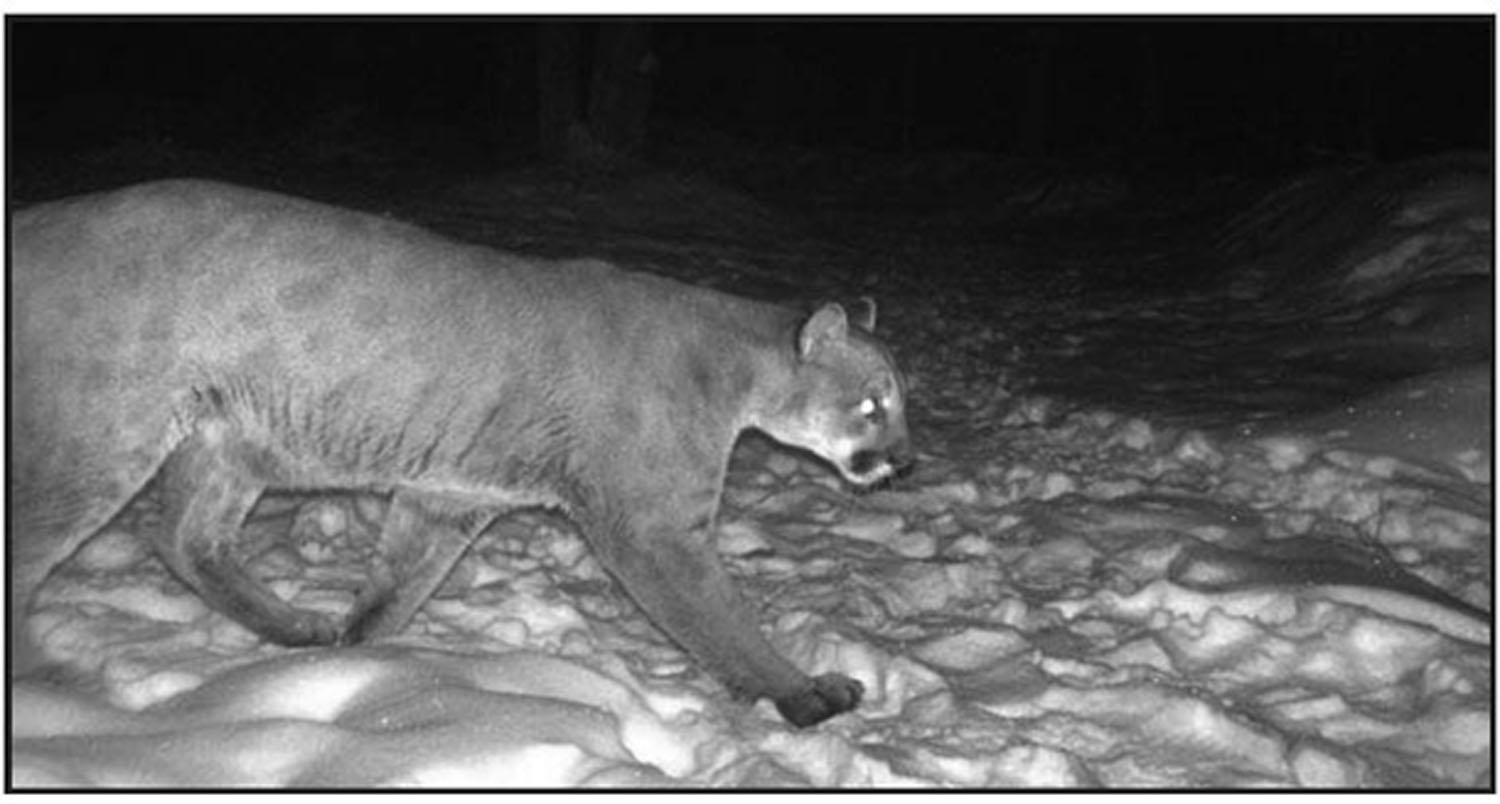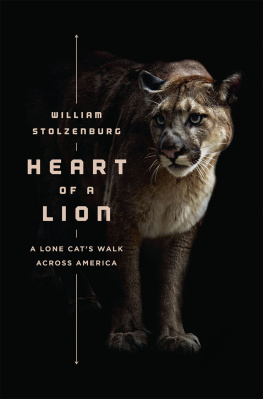To Kathy, of course, and the memory of Jean


CONTENTS
Half past midnight , June 11, 2011, on a highway seventy miles outside New York City, a mountain lion met his death on the fender of a northbound car. He was nearly eight feet long, tip to tail, and a solid 140 pounds. He was the first physical proof of a wild mountain lion in Connecticut in the last century. Soon thereafter he was to become the most famous mountain lion in North America, in any century.
The news of his demise triggered a flurry of national press and gossip. That such an unlikely beast from so deep in the past had so magically materialized in Americas iconic megalopolitan corridor came with a certain irresistible irony, serving as fodder for wild speculations.
He was a drug kingpins abandoned pet. He was an escapee from a roadside zoo. To an ardent sect of conspiracy theorists, the Connecticut cat was the smoking gun, proof at last that wildlife authorities had been clandestinely airlifting the big predators into the eastern woods to rein in a runaway population of deer. To the multitudes of citizens who swore theyd long been seeing such lions roaming their streets and backyards and local woodsthe same such lions that just three months earlier had been officially declared extinct by the U.S. Fish and Wildlife Servicehe was vindication in the face of all the authoritarian dismissals. He was undeniable evidence that eastern mountain lionsby the hundreds, maybe thousands!were in fact still thriving beneath the experts condescending noses.
He was in fact none of those things, but far more. Six weeks after scientists sliced and probed and sent bits of the lions body to a genetics lab in Montana, his tests came back and his incredible saga emerged from the molecules. He was a three-year-old mountain lion from the Black Hills of South Dakota. And he had wandered under his own power for the better part of two years and more than two thousand miles across the eastern two-thirds of North America. His journey had spanned at least six states and, most likely, Canadas largest province.
The lion had not simply walked a long distance, in the Guinness Book fashion easily imagined by any human pedestrian with a few months spare time and a supply chain of cool beverages and warm lodging along the way. This lone cat had threaded a gauntlet that would have given an elite force of Navy SEALs the night sweats. He had slinked and scampered across five hundred glaring miles of naked prairie and industrial cropland, patrolled by a certain culture of guns and antipredator hatred that had already dropped dozens of his fellow pilgrims in their paths. He had slipped through metropolises of millions, abuzz with four-wheeled predators and guarded by skittish cops armed with orders to shoot. He had forded many of the mightiest rivers east of the Rockies (the Missouri, Mississippi, St. Lawrence, Hudson) and the busiest of eight-lane freeways, some of them rumbling to more than a hundred thousand vehicles a day. Through ferocious heat, cold, rain, and snow, feeding himself on the fly in a foreign land, he made his way as far east as a land-bound animal could go, to be stopped only by the Atlantic Ocean and two tons of speeding steel.
Only after the lions headlining tragedy in Connecticut did America come to realize theyd already met this cat more than once along the way. He had made his first public appearance eighteen months earlier, on a December night outside Minneapolis, with a waltz through a suburban neighborhood captured on a police cruisers video camera. The video went viral. The lion went east. After swimming the Mississippi and scampering around the north end of the Twin Cities, he stopped for a couple days in an urban nature preserve surrounded by freeways and car dealerships, to eat a deer andmore important, for historys saketo leave behind his first fresh samples of urine and scat.
Before his pursuing biologists were through bagging that evidence, the lion was seen crossing a busy town ten miles east, on the icy banks of the St. Croix River, bordering Wisconsin. Every stop of the way, reporters followed. The lion was adopted and named, written up like an outlaw on a cross-country getaway. He became at turns the Champlin cougar, the Twin Cities cougar, the St. Croix cougar. There were cheers, there were fears, there were threats of his demise by police fire should he be caught loitering in town. Citizens were publicly warned and instructed on defending themselves against attack. The lion fled for safer surroundings.
Through his first winter on the run he continued leaving his trail of crumbs eastward across Wisconsin: a line of pancake-size paw prints and a thatch of fur at the wooded edge of a dairy farm; at another farm, another sixteen miles east, more fur, more astonishingly intimate glimpses caught by a hidden video camera. In February 2010, in Wisconsins wintry North Country, he treaded within two miles of eight thousand cross-country skiers at that moment gliding through the woods in the continents largest ski race.
Late in May he made a couple more cameo appearances on trail cameras, the last one catching him as he passed into the wilds of Michigans Upper Peninsula, eastward bound still. And then his trail went cold. Over the following months the lion went out of sight and out of the public mind.
So, when he next made his grandest entrance upon the public stage, more than a year later and another seven hundred sixty miles due eastamid the gated estates and manicured greens of Greenwich, Connecticut, thirty miles from Manhattanit was just too much to imagine. Nobody could think to connect the dots. So far as anyone knew, here was a lion fifteen hundred miles and nearly two centuries removed from genuine lion country. He could be explained only by less fantastic scenarios, as in the odd pet gone loose or the governments secret weapon air-dropped from black helicopters.
The big cats Greenwich splash played out on TV and YouTube, in the daily papers and social media. The Greenwich Mountain Lions Facebook page, which sprang up during the commotion, would soon gather five thousand friends. A blurry photo of him scared a prestigious boys school into closing its campus and the American Cancer Society into moving its annual charity walk to an indoor track in another town. Fanciful sightings streamed in from nearby communities caught up in mountain lion mania. It was lively theater while it lasted.
One week later and another forty eastward miles down the highway came the car and the end of his trail, with the DNA bombshell to follow. All those tokens of hair and bowel meticulously gathered in the wake of his Midwest crossing now revealed the genetic fingerprints linking the Connecticut cat with his South Dakota origins and the improbable chain of sightings between. This was history.
The lions trans-American trek had reached more than twice as far as that of any such cat on record, conducted by a barely weaned teenager venturing solo across strange and perilous lands. For students of dispersal biology, the journey was a godsend of data and scientific discovery. Never before had such a secretive creature, untagged and uncollared and so free to wander, left such a revealing chronicle over so wide a terrain.
For conservationists championing the return of his kind, and for public officials fearing the same, he was either emissary or omen of wild things to come. He testified to all that a certain shrinking window into eastern Americas ailing wilderness had not yet closed.
Next page







